This year is moving so fast I’m terrified I’m going to turn around twice and miss an entire month. It’s June, the plants seem about 2-4 weeks ahead and I feel about 2 weeks behind.
I’m already picking ripe cherries, the tomatoes have little proto-fruit on them and the beans are about to hit the top of the trellis. The first round of peas is nearly done and I’ve got bolting mesclun components in the greenhouse. Six weeks ago I was desperate for fresh green veg, and now, predictably, I’m drowning in rainbow-hued beets and perfect heads of Optima butterhead lettuce and – my new favorite – Farao spring cabbage. These are all lovely problems, but emphasize to me how quickly spring is charging towards summer.
I know this rhythm, this natural drumbeat. I have worked this same plot of soil for ten springs and ten summers. I know that the first tender salad and the sweet crunch of peas we cannot wait for become the lettuce we can’t eat quickly enough, become the zucchini we lose under those big squash leaves until it’s grown far too large to give away, become the tomatoes we process in giant canning marathons until our bedraggled house slippers smell like a high school locker room, become – finally – the languid, crisp fall days of collecting apples for sauce and fruit butter.
I know these transitions, the rise and fall of the productive year. As with raising a child, impossibly long, endless days somehow become years and decades that flit past like a dragonfly, lost if you glance away but for a moment.

This year the reports suggest that the Maritime Northwest is in for a hotter than typical and drier than typical summer. Or as they say around Seattle, we’re gonna get a real summer this year.
Increased heat units are generally a very good thing for those of us in this area who roll the dice on the fruiting crops like tomatoes, peppers, eggplant, melons and squash. If the predictions come true, it will be a particularly good year for tomatoes, but our summer lettuce and broccoli may sulk and bolt in the heat. Be prepared to water more, and longer. My soil is already demanding supplemental irrigation.
Plan & Purchase:
It’s time to plan the fall and overwintering garden. I know, weird, right? It gets me every year. “Brussels Sprouts? I have to think about Thanksgiving veg now?!” Yup, you do. If you are into the year-round harvest thing, now is when you get your gameplan together and start planting for things as far away as next May’s cauliflower. Trust me, I harvested the last of my 2013-planted Maystar overwintering Cauli a few weeks ago, and I was grateful to have it.
Remember: grow in summer to harvest in fall and winter. If you are new to the year-round gardener thing, you might want to read How To Make Succession Planting and Year-Round Gardening Really Work.
For our area, I like the Fall and Winter Gardening guide from West Coast Seeds. They are out of maritime British Columbia and their timeframes are excellent for coastal gardeners North of Puget Sound. Cascadia year-round gardeners South towards Portland or the California border can push their planting further into August and September with reliable success. You can download a printable PDF of the West Coast Seed chart here
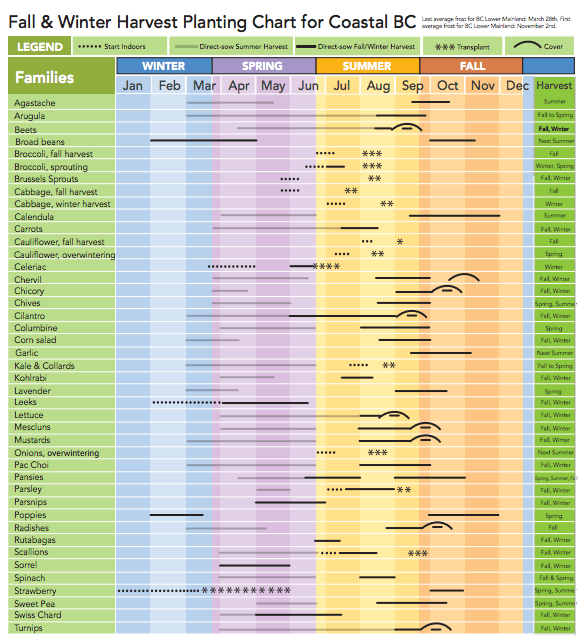
Sow Indoors
Mid June is when I start my first wave of fall and winter crops. Brussels sprouts take forever to grow, so you’ve got to start them now. Fall and winter cauliflower, winter cabbage and broccoli and kohlrabi (the big winter-keeper types) should all be started somewhere between mid-June and mid-July, depending on your particular climate and when you hope to harvest. With expectations of a particularly sunny summer, I may push my fall planting just a touch later this year.
At this time of year, if you have a greenhouse or sunny porch, you can start the fall crops outside, either in a nursery bed or in little pots. They will dry out quickly, though, so be diligent about watering. You can also turn the seed lights back on and start them indoors if that’s easier for you and the energy suck doesn’t bother you.

Be aware of what varieties you are planting. Spring brassicas aren’t bred to hold up in winter weather, so seek out varieties that will work for when you plan to harvest them. Typically, late-maturing cabbages take 100+ days to mature, while the tender speedy types are around 60-80. Rule of thumb: veg that grows slower holds longer.
Plant Outside
It’s not at all too late to get any of your direct-seeded summer crops in, but don’t delay.
- Beans – I’ve got several plantings of beans up and climbing. Pole, bush, dry, snap: try several types.
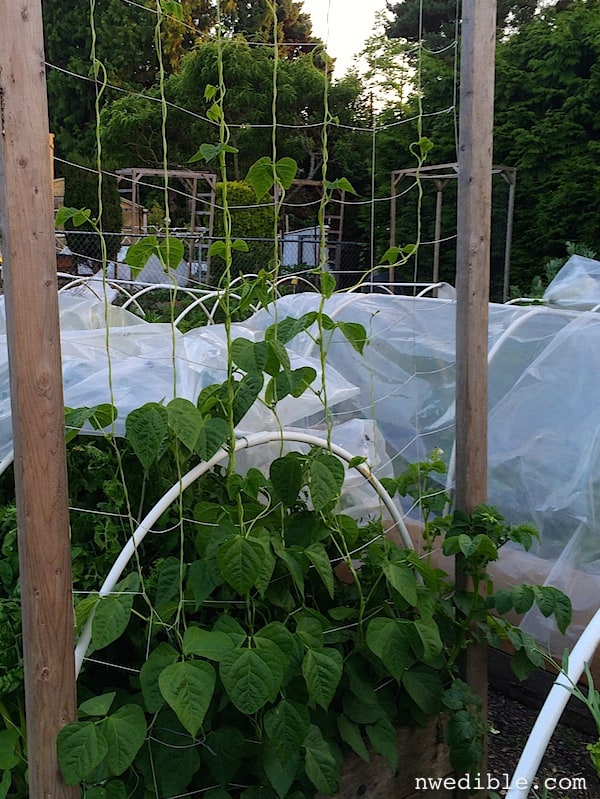
- Summer & Winter Squash – My squashes are all in and looking pretty big and awesome at this point. If you direct seed winter squash at this time of year, plant a faster maturing, smaller framed variety. Sowings of summer squash can still go in reliably.
- Melons – Plant a short season variety.
- Cucumbers – Sow directly and try trellising! Cucumbers are easy to grow vertically and you get more in an area and get much straighter cukes that way. Cukes are pretty tender but mature so quickly you could wait until the end of the month to sow and still harvest something for your trouble (but I don’t recommend delay!)
- Brassicas – Broccoli, cabbage, cauliflower, brussels sprouts, collards and kale and Asian greens like pac choi and Chinese cabbage, etc. can all be direct sown now but at this time of year you mustthink about days to maturity. Super fast maturing brassicas (many of the Asians) that would come mature in the heat of August aren’t necessarily the best idea because these crops favor cool weather and will bolt like that when the days are hot and long. With those, waiting a couple of weeks or a month so that maturation happens in cooler September is a good idea. On the other hand, very long-maturing brussels sprouts started this month will give you sprouts for Thanksgiving, whereas waiting a month may mean missing that window.
- Root Vegetables – You will have the best results in very loose open soil and I encourage you to cover your carrot and parsnip seedlings with row cover to prevent the carrot root maggot from destroying your veggies as they do mine with some embarrassing frequency. A last crop of potatoes can also be put in this month if you sow short-season varieties like Yukon Gold. Mid-to-late June is a good time for your main fall/winter sowing, along with parsnips (last chance on these), beets, rutabaga and turnips. If you are plum out of room in the garden, these crops can be sown through July but yield and harvest size will be smaller.

- Corn – ASAP.
- Salad Greens – lettuce, (every month a new sowing!) warm-weather New Zealand spinach, mustards, arugula, etc . can all be sown. Look for hot-weather adapted lettuces and salad greens. The Romaine-types are generally pretty good. Arugula and mustards bolt rapidly in warm weather and with increasing day length. Rapidly. It’s easiest with these to wait on sowing until a few weeks after the solstice.
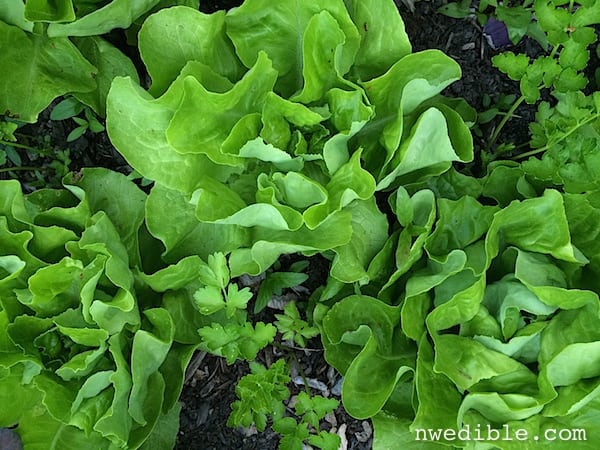
- Swiss Chard – There’s still time to plant Swiss chard for bountiful late summer and fall harvest. If you get it in this month it’ll be big and lush by October.
- Onions – green onions and overwintering leeks can be sown. Chives and garlic chives can be started in a nursery bed for a harvest next year.
- Herbs: Chives, parsley, mints, marjoram, oregano, dill, fennel, borage and the like can all be sown out. Cilantro, fennel, dill, and of course basil can all be grown. Plant lots of basil if you haven’t already! Everyone loves pesto.
Transplant Out
All your warm weather transplants: tomatoes, peppers, eggplant, etc. should be fine going out now. Overnight lows have been consistently above 50 in my neighborhood. This means, with a bit of protection (especially for peppers and eggplant), the tender stuff is ok to get in the ground if you haven’t already moved them out.
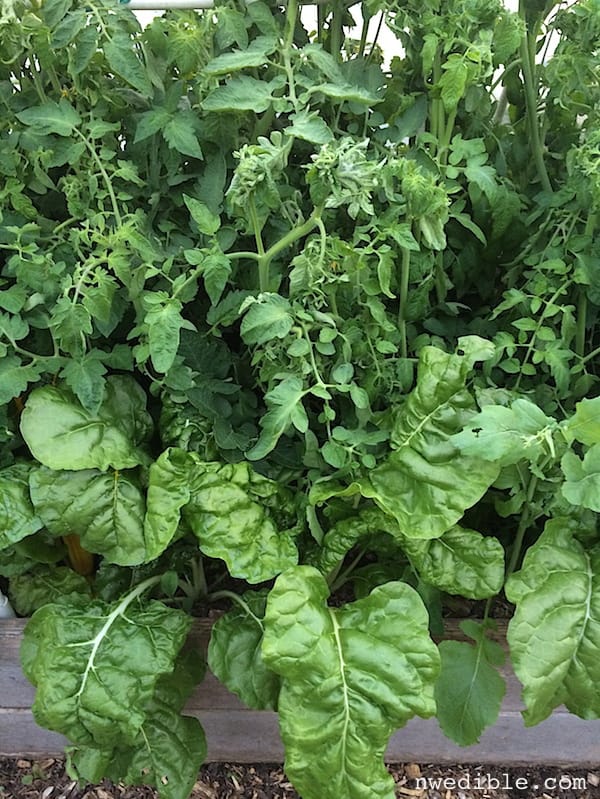
Be sensitive to where and how your transplant out. Harden your transplants gently if they are coming from a nice cozy greenhouse and be particularly gentle with eggplant and peppers, giving them a warm microclimate in which to snuggle, heat sinks (like wall-o-waters or big rocks) and extra attention, particularly if night time temps dip, which they still can at this time of year.
Harvest
All the good leafy stuff is ready.
- Peas and favas – Bush peas are nearly done, pole peas are a few weeks behind. Favas should be ready soon.
- Lettuce and other salad greens are insane. It’s Salad-Days time.
- Brassicas – Eating a tin of great early cabbage, finished up a row of tasty spring kohlrabi, and harvested the earliest broccoli already. Cauliflower leaves are pinched around the developing heads, which should be ready to eat within a week.
- Roots – Radishes, baby beets and new spring carrots are awesome this year!
- Earliest potatoes – I’m seeing blooms on many of my tater plants, which means I’ll be able to snitch out a few new potatoes before the month is up.
- Strawberries – not quite ready but the first Shuksans are blushing pink, so very soon.
- Cherries– my awesome Early Burlat Sweet Cherry from Raintree is living up to it’s name. That tree is amazing. We picked our first batch of ripe cherries on May 28th this year. There weren’t many but cherries! Real backyard cherries! In May!

- Herbs of all kind – I’m way behind on basil, but anything perennial or self seeding is running rampant. Bronze fennel for everybody!
How does the June garden look for you?
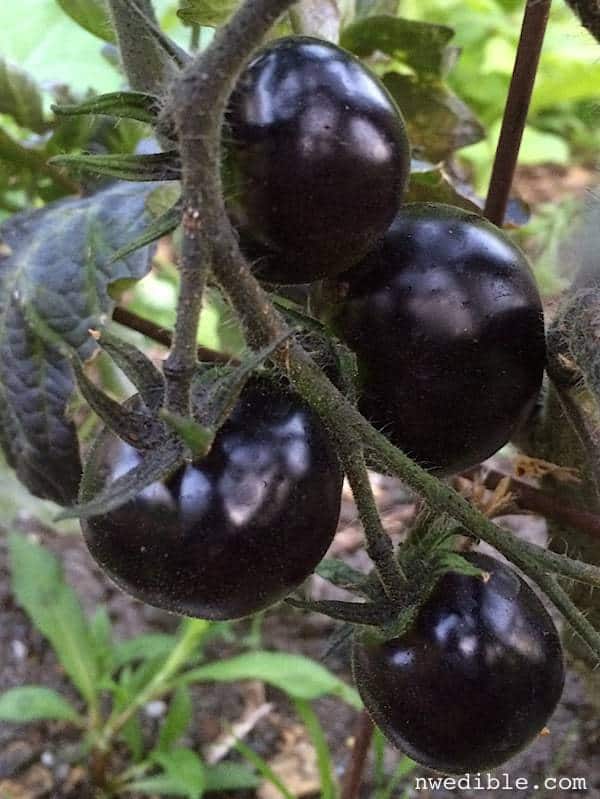
My husband and I are giving ourselves high-fives for actually getting the garden mostly planted yesterday. In fact, we think we inspired the neighbors to plant as well (peer pressure!)
Did one whole bed of seeds and lots of cherry tomatoe, zuke, and cukes. Will take your advise on trellises. You are right, never enough basil for pesto. Love the herb bed (and herbs are so stinkin expensive at the grocery store) Yikes. Last year planted 24 plants, that was too much!
I did not know about these carrot root maggots! I just planted 2 rows of carrots for seed and I’m really rooting for them. Now I’m wondering if I’ll actually get any carrots. So sad if it doesn’t work out.
You may be fine. Carrot maggot is quite regional, so it might not be an issue where you are.
Please see this site for more info on organic control of carrot maggots. They do seem to be regional, but they can be dealt with fairly easily. http://www.gardeningknowhow.com/plant-problems/pests/root-maggots.htm
Thank you!! This is very helpful and motivating 🙂
What is the plant (green leaf) in the first picture with the cabbage? I helped with a community garden and we had these donated and didn’t know what it was.
That’s nasturtium, an edible flower with a nice peppery taste. It also does a great job as a catch crop for aphids.
I love that planting chart! They were very gracious and sent me 20 copies on tagboard with catalogs for an edible gardening class I taught. It included spring on the front and fall/winter on the back. When did you plant your beets that you’re already getting a harvest? I’ve tried planting early and I just don’t seem to get much maturity until late summer. I’m on the sound near Tacoma.
I’m a little confused in looking at the cabbage (Fall Harvest vs. Winter Harvest). It seems counterintuitive that the Winter Harvest cabbage is planted earlier than the Fall Harvest cabbage, but I think I’ve got it figured out. Is that because its assumed that you’ll be planting a very long maturing variety for the Winter Harvest, vs. a very fast maturing for the Fall Harvest?
WOW! You are super ahead of me!! This year I’m feeling way behind. I JUST now have some lettuce coming ready. I did manage to harvest some chamomile and herbs and have done quite a bit of planting in the last month – berries, herbs, pumpkins, and have transplanted out tomatoes and a few other things.
Like you, I can’t believe it’s June. What the WHAT?! ACK!
Can you give an example of the early cabbage your are harvesting? Was this stuff that you planted out in early spring or overwintered? Ditto for your cauliflower is this 2014 planted stuff?
Early cauli Farao was planted mid/late Feb, transplanted out towards the end of March, and I started harvesting about 10 days ago. The Maystar cauliflower was harvested a few weeks ago – that’s an overwintering variety started WAAAAYYYY back in mid/late July 2013. My spring cauliflower, Snowball, is on the same schedule as the Farao cabbage and is just about ready to harvest now.
That’s great thanks! I’m pouring over the West Coast seeds catalogue now, and getting ready to place the order so I can start my veggies this month. My neighbour swears by planting her main carrots over the winter to avoid the carrot fly, which I’ve never had to deal with before. I’ve also just had my first experience with cabbage maggot this year (moved to a new house and this is my first garden season here)….very depressing to see my beautiful broccoli, wilt and collapse.
What a difference microclimates make! My peas are JUST NOW starting to produce. When I lived in Seattle, they would have been halfway up the Space Needle by now. I’m only 50 miles south, but it must make a big difference being inland even a little ways. Despite getting my spring stuff in on schedule, I’m only starting to get to enjoy the spring veggies. I think part of the problem was the extra 10 inches of rain we got before the end of March. Historically, if I’ve planted peas on March 1st, that sowing will be slow but will at least come up. I had to resow a couple of times this year…I think the seeds just got soaked and rotted.
In a fit of desperation, I threw some red potatoes I had sprouting in the cupboard in mid-March and crossed all digits that we wouldn’t get a hard frost….and we didn’t! So, I am going to have potatoes for the first time, which is exciting.
I had planned to have a rainwater catchment system in by now, but plans got delayed, so I ended up planting a lot less than I had planned. I am on a five-property shared well and, after last year’s endless hot summer, I have to be really careful about how much I draw it down. Here’s to getting a little more rain than we did last summer. Next year, BIG GARDEN!
The June garden is very different for us south of the equator – but I fully second your point of getting on top of the winter garden in summer. It’s the only reason I have maturing brassicas now when I need them.
But I love hearing about summer time gardens while we are in the depths of winter.
Grape-leaves are getting ready to be harvested. Dandelions and garlic-mustard are still going strong (want to try lacto-fermenting garlic mustard, as I think that will calm down the oxalis a little bit). Serviceberries, red currants, and sour cherries are setting fruit and edging towards ripeness (4-6 weeks away, but coming!) while apples and pears are setting fruit but nowhere near ripe yet. Farmers’ Markets have just opened, so there will be greenhouse tomatoes and cucumbers coming up soon, and there will be peas, green onions, herbs, and leafy greens floating around already
Your cherries look AMAZING, and I am envious. 🙂
love the chart and will save it for next summer. shoulder surgery has left me with only one good arm temporarily so the garden will consist of tomatoes and basil in big pots. i’ll get my garden-fix vicariously enjoying your hard work. congratulations on the book project, it will be so cool to buy my very own copy!